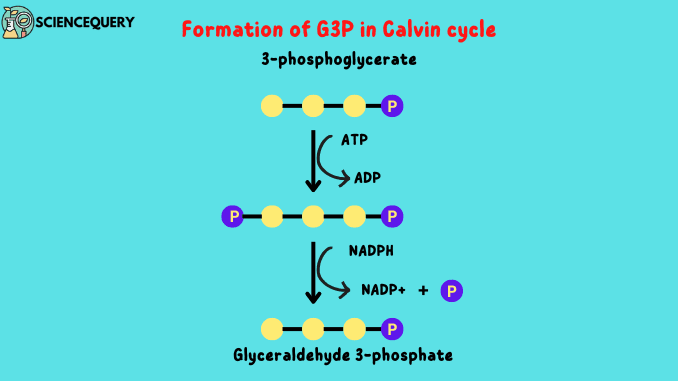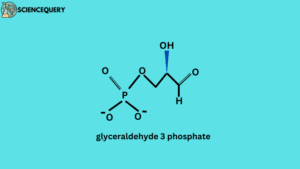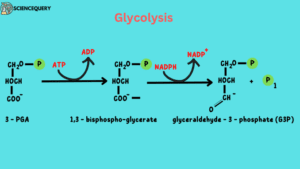
Know in one minute about G3P or Glyceraldehyde – 3 – phosphate
|
Introduction
Glyceraldehyde – 3 – phosphate or G3P is an intermediate compound in several metabolic pathways like glycolysis, the Calvin cycle, gluconeogenesis, and the pentose phosphate pathway.
- It is also known as triose phosphate.
- A key player in metabolic pathways.
- It is involved in the biosynthesis of tryptophan, thiamin, and phospholipids.
- Is three carbon sugars that are produced in the Calvin cycle. It is the entry point for photosynthesis.
- G3P is the metabolic precursor of the three-carbon glycerol backbone of triacylglycerols.
Structure of G3P

IUPAC
- (2-hydroxy-3-oxopropyl) dihydrogen Phosphate
G3P in Calvin cycle
- Calvin cycle is a light-independent reaction. Glyceraldehyde-3-phosphate is produced as one of the intermediate molecules in the Calvin cycle.
- It is the first stable intermediate compound in this cycle. Carbon dioxide enters the Calvin cycle during carbon fixation.
- The resulting six-carbon molecules quickly break down into two 3 carbon molecules.
- These 3 carbon molecules are then converted into glyceraldehyde-3-phosphate with the addition of phosphate by ATP and the addition of electrons by NADPH.
- For producing 1 molecule of G3P we need to reduce 3 carbon dioxide molecules and to produce one molecule of sugar we need two molecules of G3P.
Formation of G3P in Calvin cycle
♦ It is formed in the second stage of the Calvin cycle. The second stage of the Calvin cycle is reduction.
♦ Phosphorylation of PGA (Phosphoglyceric acid) reacts with ATP and produces 1,3 – diphosphoglyceric acid which is formed by carboxylation. This reaction is catalyzed by phosphoglycerokinase enzymes.
PGA + 12 ATP → 1,3-Diphosphoglyceric acid + 12 ADP
♦ Reduction of 1,3 – diphosphoglyceric acid(1,3-DPGA)1,3 DPGA reduced by NADPH + H+ which is given by light reaction. It is formed of 12 molecules of G3P. This G3P produces another hexose sugar.
1,3 – DPGA + 12 NADPH + 12H → G3P + 12 NADP
G3P in glycolysis
- Glycolysis is the metabolic pathway. It takes place in the cytoplasm.
- It is an important intermediate in the glycolysis pathway.
- Glycolysis is the first stage of respiration. In glycolysis, glucose is degraded into Pyruvic acid in several more stages.
- The sugar molecule is phosphorylated and split in half, producing two molecules of glyceraldehyde 3 phosphates.
- This compound is then converted into pyruvate after more steps.
Steps of glyceraldehyde – 3 – phosphate in glycolysis
A preparatory stage in which the hexose glucose is phosphorylated and cleaved into two molecules of Glyceraldehyde – 3 – phosphate, the process utilizes two ATP in a kind of energy investment.
1. Phosphorylation of glucose
In the presence of the enzyme hexokinase, glucose reacts with ATP and produces Glucose-6-phosphate.
Glucose + ATP → Glucose – 6 – phosphate
2. Isomerization of glucose 6 phosphate
In the presence of phosphohexose isomerase enzyme glucose – 6 – phosphate converts into its isomer fructose 6 – phosphates.
Glucose-6-phosphate → Fructose 6 phosphate
3. Phosphorylation of fructose – 6 – phosphate
Fructose – 6 -phosphate reacts with ATP to produce fructose – 1,6 diphosphate in the presence of phospho hexokinase enzyme.
Fructose – 6 – phosphate + ATP → Fructose – 1,6 diphosphate
4. Cleavage of fructose – 1,6 diphosphate
In the presence of aldolase enzyme fructose – 1,6 diphosphate formed G3P and dihydroxyacetone phosphate (DHAP)
Fructose-1,6-diphosphate → G3P + DHAP
5. Isomerization of DHAP
DHAP is an isomer of G3P. DHAP converts to Glyceraldehyde – 3 – phosphate in the presence of triose phosphate isomerase enzymes.
Summary of glycolysis
In the overall reaction, 2 molecules of Glyceraldehyde – 3 – phosphate are formed by one molecule of glucose.

Significance
1. Formation of hexose sugar
2. In the Calvin cycle it is a key intermediate compound that produces other hexose sugar.
3. Regeneration of the CO2 acceptor – ribulose 1,5 diphosphate (RuBP) Glyceraldehyde – 3 – phosphate and dihydroxyacetone phosphate are actively participating in the regeneration of RuBP.
4. It is an important intermediate for the complete respiration process. Glycolysis is part of respiration. In glycolysis, glucose is split in pyruvate. G3P plays an important role in the degradation of glucose to generate energy.
The compound produces G3P in Glycolysis and Calvin cycle
- In the Calvin cycle, 1,3 – diphosphoglyceric acid produces G3P in the presence of dehydrogenase enzyme.
- In Glycolysis fructose-1,6 diphosphate formed G3P in the presence of an aldolase enzyme.
- Dihydroxyacetone phosphate (DHAP) is an isomer of G3P, DHAP converts in its isomer and forms Glyceraldehyde – 3 – phosphate.
Q&A
What is G3P?
It is a key intermediate in several metabolic pathways like glycolysis, the Calvin cycle, and gluconeogenesis and plays an important role in the biosynthesis of phospholipids, tryptophan, and thiamin.
How many g3p to make glucose?
12 molecules of glyceraldehyde – 3 – phosphate are used for producing sugar.
What is G3P in the Calvin cycle?
It is an intermediate compound in the Calvin cycle. It is a starting point for the formation of other sugar molecules.
What molecules are providing energy for the production of G3P?
Phosphoglyceric acid and 1,3 – diphosphoglyceric acid give energy for the production, this energy is given by the light reaction of photosynthesis.
What is needed to convert PGA into G3P in the second step of the Calvin-Benson cycle?
The second step of the Calvin cycle is reduction. We easily understand what we needed for the formation of G3P by these reactions of the Calvin cycle.
In the presence of phosphoglycerokinase enzyme, 12 molecules of PGA with 12 Molecules of ATP formed 1,3 – diphosphoglyceric acid by phosphorylation.
PGA + 12 ATP ⇔ 1,3 – DPGA + 12 ADP
1,3 – diphosphoglyceric acid is reduced by NADPH + H which is formed in a light reaction, in this reaction 12 molecules of G3P are produced in the presence of dehydrogenase enzyme.
1,3-DPGA + 12 NADPH + 12H ⇔ 3-G3P + 12 NADP + 12H3PO4
G3P is used in which of the following processes?
It is used in many metabolic pathways as an important intermediate. It is mainly used in glycolysis, the Calvin cycle for the production of other sugar, it is intermediate in the pentose phosphate pathway and gluconeogenesis.
What kind of molecule is G3P?
It consists of two groups, one aldehyde, and one phosphate group. G3P is a monophosphate ester and is a 3-carbon sugar molecule. See the diagram in the article for the Glyceraldehyde – 3 – phosphate.
At which point is G3P removed from the Calvin cycle to be used in the production of carbohydrates?
Is removed in the second stage of the Calvin cycle. The second stage is hexose sugar formation.12 Molecules of Glyceraldehyde – 3 – phosphate convert into other carbohydrate molecules by different reactions.
- 5 molecules are converted in dihydroxyacetone phosphate(DHAP)
- 3 molecules are with 3 molecules of DHAP convert in fructose 1,6 diphosphate
- 2 molecules convert in ribose 5 phosphate
- And other 2 molecules convert in xylulose – 5 – phosphate.
Written By: Richa Pachori
References
